Feeding and proper diet of pigs
Some aspiring livestock breeders believe that the pig is able to eat any food that is offered to it. Indeed, these animals are omnivorous and capable of absorbing many different foods. There were cases when adult boars or queens ate small animals in the courtyard (although these cases are rare). However, this does not mean that pigs can be fed with whatever food is available: weight gain depends on how well the pigs are fed.
- Basic Guidelines for Pig Diet Formulation
- Choosing a breed for fattening
- Pig feeding options
- Feeding adult pigs for slaughter
- Stages of feeding adult pigs
- Feeding adult pigs with low calorie feed
- Intensive feeding of adult pigs
- Formulation of a ration for fattening adult pigs
- Feeding piglets under six months of age
- Piglet Feeding Tips
- Piglet feeding regime
- Feeding a pregnant sow
- Conclusion
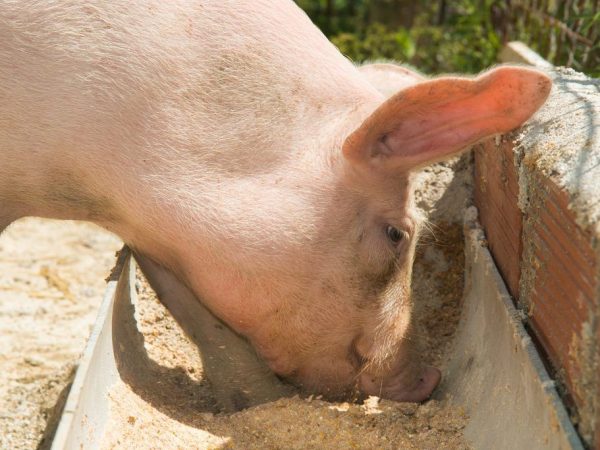
Feeding pigs
Basic Guidelines for Pig Diet Formulation
Before deciding what and how to feed pigs, you need to figure out what basic rules are used to compose their diet. On large farms, feed is purchased in bulk, which makes the diet less varied. You also need to find out that the pig is easy to digest, and what kind of food is hard for her body to digest. For novice livestock breeders, it is recommended to clarify what breed of pig: meat, meat-lassing and greasy varieties are fed in different ways, so you need to decide what you need more: meat, lard, or both equally.
When fattening, it is better to clarify in advance which direction of production the breed belongs to. For example, Vietnamese pot-bellied pigs (or, as they are sometimes called, Lop-eared pigs) are bacon varieties. Only after the breed has been clarified, it is necessary to start feeding so that the pig gains weight the fastest.
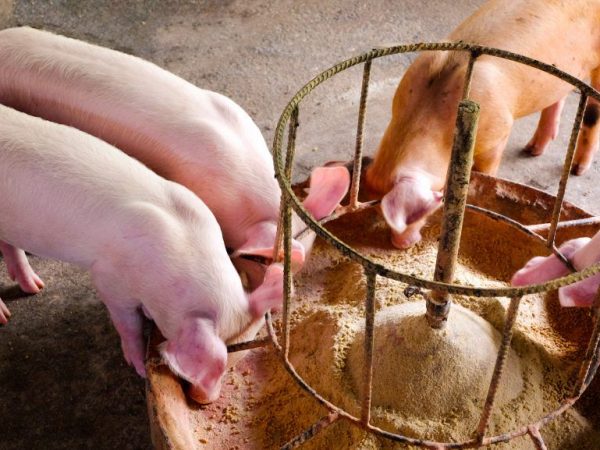
Preparation of a ration for pigs
Not all animals are given a diet for the purpose of rapid gain in body weight. There are several special cases in which the diet has to be compiled separately:
- The ration of the breeding stock. These queens and boars are not sent for slaughter: they are needed for further breeding and increasing the herd - the diet for them is compiled with an eye to improving health. In no case should you save on these animals, because the farmer's profit depends on them.
- The diet of young animals. You need to be very careful about what to feed the little pigs. Immediately after weaning from their mother, they are very vulnerable, they need quality food. Moreover, the food must be chosen correctly so that the kids do not get worse after such a meal.
- Feeding sows. The feed for the pigs from which the offspring will be obtained is selected with particular care. A special table is compiled by month, according to which the sow's diet changes. All this is necessary in order for her to give birth to healthy offspring, and then she could give a sufficient amount of milk.
But this is not all that is worth remembering.Feeding should be done according to a specific schedule, while taking into account how much food the pig consumes per day. Sometimes too much food can harm, not benefit. And the quality of food should be closely monitored. In no case should you feed your pig with rotten, frozen potatoes or drunken cherries. There is no guarantee that after such food the pig will remain alive, therefore it is so important to be able to correctly and thoughtfully compose the diet for these animals.
Choosing a breed for fattening
Even before a farmer knows what to feed domestic pigs, he will have to choose the right breed of these animals. If you buy farm pigs that were hatched without a separate plan, they will gain weight slowly, and the cost of buying feed will be very high. Here, even such compound feeds as Purina will not help with weight gain. Although in order for the pets to grow faster, it is necessary to take suitable feed for the pigs. But thoroughbred Vistula pigs are able to grow faster than ordinary rural pigs.

Breed selection
If we talk about choosing a breed for fattening, then here you need to take into account the market requirements and your own preferences. When a farmer decides to raise a pig in order to acquire meat, he should choose the breed and type of feeding to his taste. But when raising pigs for sale, everything is somewhat more complicated. At the moment, lean lean meat is very popular, so you should pay attention to meat varieties and only after that proceed to buying a suitable pork feed for the selected breed.
Pig feeding options
So, the farmer has acquired an adult pig or piglet, and now he needs to choose the appropriate feeding regime, while it is important to avoid such dangers as overfeeding, excessive food consumption or health problems. In some cases, there is a chance to see how the pig that has eaten stops breathing, and all because of inappropriate food.
Both in industrial and at home, feeding is carried out in one of 3 main directions. Some breeds are bred for one type of feeding, while others are a kind of generalists:
- Fattening piglets for meat. Piglets are used here, which, depending on the variety, are sent to slaughter at the age of 6-8 months. They quickly gain weight and clog when they reach 110 kg. This is a classic figure that experienced miners are always guided by. Slaughtering smaller piglets is not profitable, so people with experience do not try to do this.
- Bacon feeding. Here, the product is already more fatty, and there are always layers of fat in the meat. Growing here takes place under different conditions than when obtaining lean meat. Piglets selected for bacon fattening should weigh 25-27 kg at the age of 85-95 days. There are special breeds that are best suited for this type of cultivation.
- The last type is the so-called fattening. In Ukraine, such a fattening is called easier and more understandable - lard. They use meat-sucking pigs or adult animals that have been rejected for one reason or another. Fattening is also carried out according to certain rules, in violation of which both meat and lard (or lard) are of poor quality and are not suitable for consumption.
It should be borne in mind that meat and bacon are more in demand on the market than lard, so it is on them that pigs are usually fed. And in terms of costs, bacon and meat methods are cheaper than fattening. But the cultivation of pigs for lard also should not be discounted, because tasty and high-quality lard is also selling well. Ultimately it all depends on the available feed, breed and other individual factors. To a large extent, the preferences of the farmer himself also influence.
Feeding adult pigs for slaughter
To obtain meat or bacon, animals of any breed can be used, but it is important not only the feeding of the pigs itself, but also the characteristics of the young animals used. We need piglets whose weight at the age of 90-120 days is at least 25 kg, and ideally 30-35 kg. The diet and principles of feeding piglets at home are somewhat different from those used on large farms. More precisely, the principles remain the same, but there are certain differences in the composition of food.
There are ready-made combined or concentrated feeds that are used specifically for pork production. And they can be used at home, not only on farms where a herd of 25 heads is kept on a site of 20 square meters. For example, products of the K-55 brand are often used for pigs, which provide a fairly intensive increase in live weight. It should be understood that dry food, as well as too liquid, slow down the rate of weight gain.
To prevent the compound feed from being too liquid, it must be diluted with clean lukewarm water. The norms are as follows: 1 kg of feed accounts for 1.3 liters of water. All this is thoroughly mixed and given to the animals. These liquid mash are great for daily feedings. But it must be borne in mind that when calculating how much feed should be given per day, the mass of dry feed not diluted with water is taken. When calculating the daily rate, it must be borne in mind that they are all made not in kg, but in feed units.
Stages of feeding adult pigs
This division applies to all types of feeding. Feeding domestic pigs in the first step requires a balanced diet with a full complement of vitamins and beneficial nutrients. The food that the pig eats should be moderately nutritious, since a lack of protein slows down its growth rate. For example, at the beginning of feeding, meat pigs should receive 190-210 g of protein every day. At the same time, for those piglets that have reached a weight of 60 kg, the daily norms are 270-320 g.
Upon reaching a mass equal to 60-70 kg, it is time to move to the second stage of fattening. Here, the amount of protein (those same proteins) can be somewhat reduced. For example, feeding pigs that have reached a mass of 100 kg or more implies the presence of proteins in the food. But their number does not exceed 360-380 g per day. That is, the ratio of feed and protein in it decreases with increasing weight of animals. At the same time, the ratio of liquid to dry feed remains unchanged throughout the entire feeding period.
Feeding adult pigs with low calorie feed
Before feeding pigs with such feeds, one must take into account that the rate of weight gain in the end will be low, which is a serious drawback in the eyes of livestock breeders. In such conditions, pigs feed mainly on grass, food waste and other similar foods. The quality of the meat is not high enough, although it is quite suitable for home use. Such feeding is suitable if there is access to a large amount of quality meadow grass.

Fattening pigs
The main problem in this case is this: in the meadow grass, protein may be lacking, which slows down the growth of animals, so you have to add high-calorie juicy feed to the diet. Feeding with some concentrates is also used. All this is needed in order to balance the diet of the pigs. But this must be done so that feeding does not increase the amount of protein food above the required rate. In winter, hay is used instead of meadow grass: it is more nutritious. Hay from alfalfa or clover equals 0.6-0.75 feed units.
Intensive feeding of adult pigs
In total, there are 3 main options for feeding domestic pigs. All of them are used by farmers to obtain high-quality pork that meets GOST. It is always important here not only how much feed the pig eats, but also what exactly it eats.The quality of the food received plays an important role, because it depends on what vitamins and nutrients the animal receives. Here is a table that shows the composition of the diet for fast growth and weight gain with meat pigs:
| Feeding types | Compound feed in food in summer | Juicy food in summer food | Animal squirrel in summer | Compound feed in food in winter | Juicy food in food in winter | Animal protein in winter |
| Classic intensive way | 80-85% | 5-13% | 2-3% | 85-90% | 1-8% | 2-3% |
| Root method | 60-75% | 15-35% | 2-3% | 65-80% | 10-30% | 2-3% |
| Feeding with food waste | 65-70% | 30-35% | 2-3% | 70-75% | 25-30% | 2-3% |
Even in summer, food for pigs should be varied with grass for the vitamins that it contains. Root feeding is usually divided into 2 main types: feeding with fodder beets, carrots, Jerusalem artichoke and feeding with potatoes. At the same time, the mixture with potatoes contains up to 30-35% of this root crop, while food is diluted with beets or carrots in smaller quantities. It should also be remembered that you can feed the pigs with sugar beets, but it will be too expensive.
Formulation of a ration for fattening adult pigs
Ready-made compound feed can be replaced with hand-made mixtures, and these mixtures can be used for any type of feeding. Feeding types differ only in the percentage of different foods. When composing a mixture for fattening, one must take into account the influence of various feeds on the future quality of pork. The technology for making up the diet is very simple. Conventionally, all the food that the pig receives can be divided into 3 groups, according to the quality level. Here they are:
- The first food group. With its help, high quality pork is obtained, but these feeds are distinguished by a higher price. This includes most cereals such as wheat, millet and other types of grain. In addition to grain, it is also worth mentioning carrots, sugar and fodder beets, legumes. This is why pigs are often fed peas, wheat and fodder beets. They are also fed with pumpkin or barley.
- The second group is medium quality feed. If you use only them, the meat will be of poor quality with a lot of fat. But it is worth combining them correctly with food from the first group - and you get a full-fledged diet. This group includes corn, potatoes and bran. That is why bran is fed only together with wheat or other similar types of grain.
- The third group is cheap, poor quality feed. This includes soybeans, oats and various food waste, as well as various cakes and pulps. Pulp, oats or soy cannot be fed to pigs, but you can dilute the diet with them. If what the pig eats is 20-25% of the feed of this group, it will benefit her. Ideally, you should combine foods from all three groups.
So how is the diet composed? 50-60% of feed from the first group is taken. With root feeding, they make up 70-80% of the entire portion. Of the grains, it is worth using primarily barley and wheat, which make up 50-60% of the total mass of grain. About 10% of corn, oats are also taken, do not forget about the bran. Even when composing portions, they use raw buckwheat and peas, the proportion of which should also not exceed 10%. But there is no need to feed animals with bread.
This is not all about how to properly feed pigs when feeding meat. It is imperative to add juicy feed to the portions. In summer, it is better to feed with pumpkin, cucumbers, fresh peas, and herbs, for example, nettles. Potatoes, as well as red beets, can be fed both in winter and summer. In addition to potatoes in winter, it is worth using harvested silage, which can replace fresh grass and tops of plants. At the same time, it is better to make porridge from dry feed: it is easier for animals to eat such porridge.
Feeding piglets under six months of age
The best food for growing piglets up to one month of age is mother's milk. But even newly born babies need not only milk, but also vitamins, as well as premixes for accelerated growth.Usually, in order to feed the suckers, the uterus is enough, the person only needs to add vitamins. The starter complex of premixes and vitamins is usually supplied in granules. Difficulties begin when the uterus refuses to breastfeed the piglets and no longer gives milk.
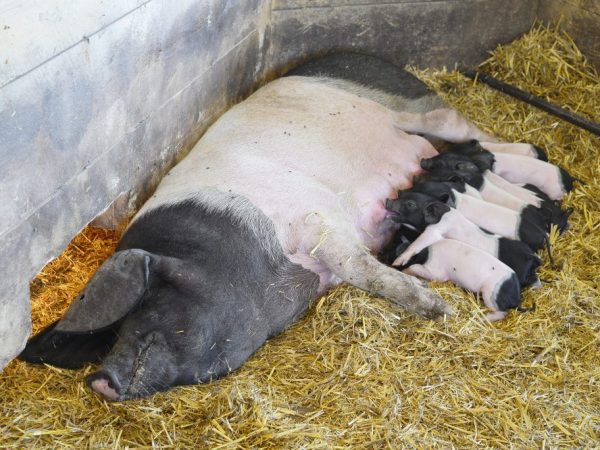
Feeding piglets
Even if the sow has not refused to feed the babies, milk alone will not be enough for them. Here you need to know how piglets are fed at home. Newborn pigs are fed with premixes for suckling pigs from the third day. It is necessary to accustom every little sucker to them as early as possible, so that they independently take these feedings. On the fifth day, you can drink them with cow's milk, and after a week you can feed the kids with various cereals.
Some farmers feed little pigs with jelly made from oatmeal. It is also given one week after giving birth. It is needed so that babies gain weight quickly, although they need liquid food most of all, already on day 10 they can be fed with soft hay, for example, tops of peas or beans. Proper feeding of growing piglets also includes a certain amount of succulent feed. But extruded feed will suit them only of the highest quality and only from one month of age.
Piglet Feeding Tips
First, it is important to know what is the best way to feed small pigs. Moreover, the recommendations are the same for breastfed gilts, and for those who are transferred to artificial feeding. Weaners are usually fed with milk replacer - whole milk substitutes. In order to artificially raise piglets, it is necessary to accustom them to the fact that feeding is carried out by humans, so the farmer will have to feed them with milk every day with his own hands. Such care will accustom kids to the owner from an early age.
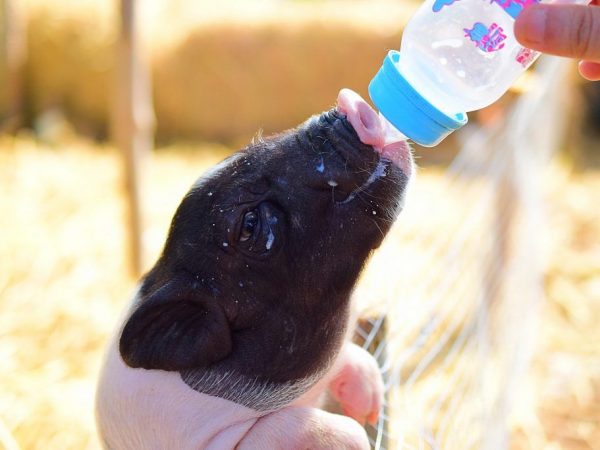
Feeding a piglet with milk
What should not feed pigs in the first month of life? Sunflower seeds, onions, fish, bread, pumpkin and other similar foods. Nothing other than milk should be given from animal feed. By the way, adult pigs are fed with fish, bone meal and other similar products in small quantities, therefore, in order to avoid problems with nutrition, it is better for novice livestock breeders to use ready-made feed from reliable manufacturers. But you need to make sure that the cost of food does not become high.
You should always make sure that little ones do not eat from the same trough with adult pigs. As already mentioned, those types of feed that will go for adult boars are not suitable for piglets. For example, acorns are good food for fattening meat, but babies are not always able to digest them. Some animals are able to eat almost any food, while others turn out to be very capricious and demanding on food, so this issue needs to be approached individually.
It is important not only what the guinea pigs eat, but also the feeding schedule.
Piglet feeding regime
If we talk about the regime, then a healthy pig eats 6-7 times a day, because it has a small stomach. It is not at all difficult to teach an animal to eat right. It often happens that the baby lies sluggish or, on the contrary, shakes, as in a fever. The problem may be illness, worms, or poisoning.
Often, the problem can be prevented simply by using the correct feeding regime, because a common cause of poor health is banal overfeeding.
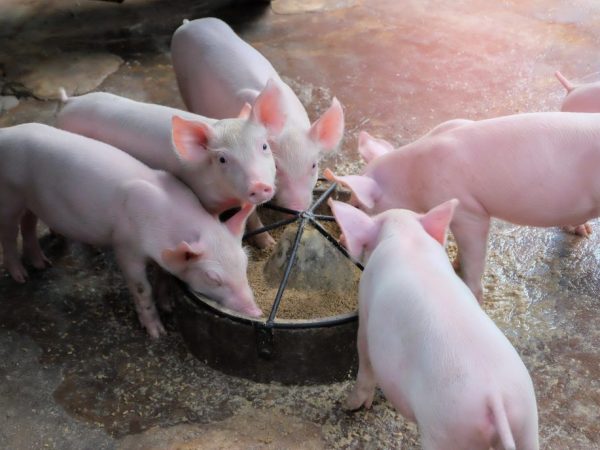
Piglet feeding regime
Everyone wants to quickly fatten pigs in order to send them to slaughter early. But if you give them large amounts of food at a time, it will only get worse. It happens, of course, that some piglets calmly overpower portions, while others immediately feel bad. But it is better to give portions based on weaker babies. It is also worth feeding the babies with salty food or giving salt separately to improve digestion.
Feeding a pregnant sow
It is worth talking about how a pregnant pig is raised. Its correct content will be the start of economic development. And it doesn't matter if the piglets will then be kept separately with her. In any case, the health of its future offspring depends on the quality of nutrition that a pregnant pig receives. It turns out that the better the pregnant sow is fed, the higher the farmer's profit. Without this, there is no chance of getting healthy piglets.
Some farmers recommend (it's even shown on the video) to give the uterus really a lot of food. Moreover, everything that is recommended for adult pigs is used: corn, wheat, barley, oats, juicy feed and protein foods. In fact, it all depends on the quality of the food, and the portions should be even slightly smaller. They are reduced by 1/5 of the usual mass. You can do your own food preparation or buy ready-made feed for sows, although ready-made feed alone is not always suitable.

Raising a pregnant pig
Complementary foods with vitamins are a great choice. Granulated vitamin feed for sows is definitely needed.
So that the pig does not stop bearing offspring, it is necessary to feed it twice a day. Animal feed should be a quarter less than in the standard fattening diet, and portions should be prepared taking into account the fact that a pregnant pig only needs the highest quality feed. Here is what livestock breeders write on the forums about the maintenance of a pregnant sow:
“The quantity and quality of the feed received is very important when a pig is pregnant. Moreover, the recommendations are the same both for ordinary pigs and for black Vietnamese animals. You can use both ready-made feeds (their production has been established for a long time), and you can choose your own diet. You just need to choose the best option: high-quality grain, juicy and fresh roots, fragrant hay or grass. Before farrowing, you should halve the portions (2-4 days before delivery). "
Conclusion
Keeping and feeding pigs is not the most difficult, but responsible task. It is imperative to choose the right feed and diet, only then all the costs will pay off.


